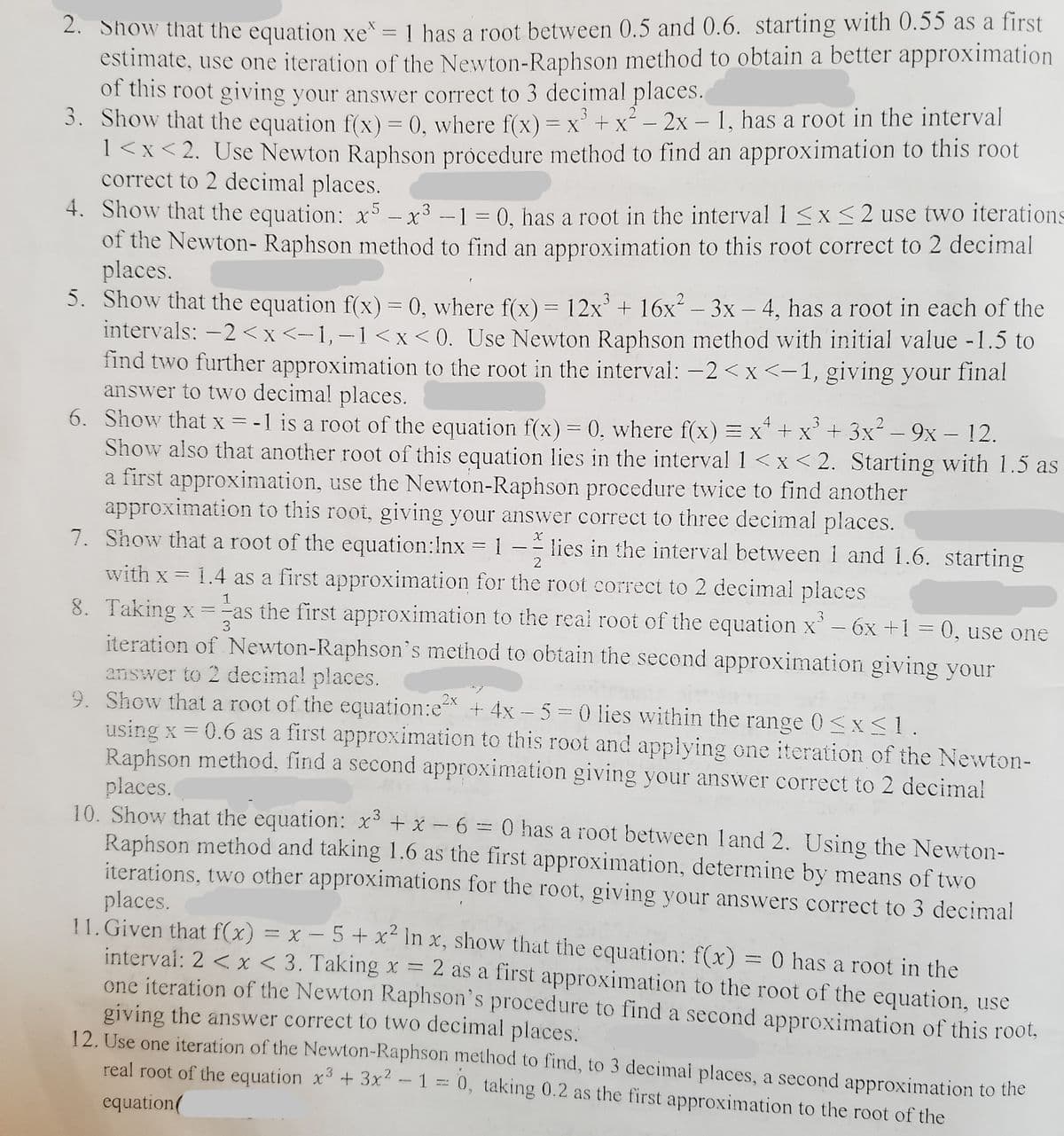2. Show that the equation xe = 1 has a root between 0.5 and 0.6. starting with 0.55 as a first estimate, use one iteration of the Newton-Raphson method to obtain a better approximation of this root giving your answer correct to 3 decimal places.
2. Show that the equation xe = 1 has a root between 0.5 and 0.6. starting with 0.55 as a first estimate, use one iteration of the Newton-Raphson method to obtain a better approximation of this root giving your answer correct to 3 decimal places.
Advanced Engineering Mathematics
10th Edition
ISBN:9780470458365
Author:Erwin Kreyszig
Publisher:Erwin Kreyszig
Chapter2: Second-order Linear Odes
Section: Chapter Questions
Problem 1RQ
Related questions
Concept explainers
Equations and Inequations
Equations and inequalities describe the relationship between two mathematical expressions.
Linear Functions
A linear function can just be a constant, or it can be the constant multiplied with the variable like x or y. If the variables are of the form, x2, x1/2 or y2 it is not linear. The exponent over the variables should always be 1.
Question
Solve Q2, 3 explaining detailly each step

Transcribed Image Text:2. Show that the equation xe = 1 has a root between 0.5 and 0.6. starting with 0.55 as a first
estimate, use one iteration of the Newton-Raphson method to obtain a better approximation
of this root giving your answer correct to 3 decimal places.
3. Show that the equation f(x) = 0, where f(x) = x° + x² – 2x – 1, has a root in the interval
1<x<2. Use Newton Raphson pròcedure method to find an approximation to this root
correct to 2 decimal places.
%3D
4. Show that the equation: x5 - x³ -
of the Newton- Raphson method to find an approximation to this root correct to 2 decimal
places.
5. Show that the equation f(x) = 0, where f(x) = 12x + 16x – 3x – 4, has a root in each of the
intervals: -2 <x <-1, -1<x <0. Use Newton Raphson method with initial value -1.5 to
find two further approximation to the root in the interval: -2 < x <-1, giving your final
answer to two decimal places.
6. Show that x = -1 is a root of the equation f(x)= 0. where f(x) = x* + x' + 3x² – 9x – 12.
Show also that another root of this equation lies in the interval 1<x<2. Starting with 1.5 as
a first approximation, use the Newton-Raphson procedure twice to find another
approximation to this root, giving your answver correct to three decimal places.
7. Show that a root of the equation:Inx = 1
1 = 0, has a root in the interval 1<x<2 use two iterations
-
lies in the interval between i and 1.6. starting
- -
2
with x = 1.4 as a first approximation for the root correct to 2 decimal places
8. Taking x =-as the first approximation to the real root of the equation x'– 6x +1 = 0, use one
iteration of Newton-Raphson's method to obtain the second approximation giving your
answer to 2 decimal places.
9. Show that a root of the equation:e + 4x - 5 = 0 lies within the range 0 <x<1.
using x = 0.6 as a first approximation to this root and applying one iteration of the Newton-
Raphson method, find a second approximation giving your answer correct to 2 decimal
places.
10. Show that the equation: x³ + x - 6 = 0 has a root between land 2. Using the Newton-
Raphson method and taking 1.6 as the first approximation, determine by means of two
iterations, two other approximations for the root, giving your answers correct to 3 decimal
places.
11. Given that f(x) = x – 5+ x² In x, show that the equation: f(x) = 0 has a root in the
interval: 2 < x < 3. Taking x =
one iteration of the Newton Raphson's procedure to find a second approximation of this root,
giving the answer correct to two decimal places.
12. Use one iteration of the Newton-Raphson method to find, to 3 decimai places, a second approximation to the
real root of the equation x + 3x -1 = 0, taking 0.2 as the first approximation to the root of the
1
3
2x
2 as a first approximation to the root of the equation, use
.3
equation(
Expert Solution
This question has been solved!
Explore an expertly crafted, step-by-step solution for a thorough understanding of key concepts.
Step by step
Solved in 6 steps

Knowledge Booster
Learn more about
Need a deep-dive on the concept behind this application? Look no further. Learn more about this topic, advanced-math and related others by exploring similar questions and additional content below.Recommended textbooks for you

Advanced Engineering Mathematics
Advanced Math
ISBN:
9780470458365
Author:
Erwin Kreyszig
Publisher:
Wiley, John & Sons, Incorporated

Numerical Methods for Engineers
Advanced Math
ISBN:
9780073397924
Author:
Steven C. Chapra Dr., Raymond P. Canale
Publisher:
McGraw-Hill Education

Introductory Mathematics for Engineering Applicat…
Advanced Math
ISBN:
9781118141809
Author:
Nathan Klingbeil
Publisher:
WILEY

Advanced Engineering Mathematics
Advanced Math
ISBN:
9780470458365
Author:
Erwin Kreyszig
Publisher:
Wiley, John & Sons, Incorporated

Numerical Methods for Engineers
Advanced Math
ISBN:
9780073397924
Author:
Steven C. Chapra Dr., Raymond P. Canale
Publisher:
McGraw-Hill Education

Introductory Mathematics for Engineering Applicat…
Advanced Math
ISBN:
9781118141809
Author:
Nathan Klingbeil
Publisher:
WILEY

Mathematics For Machine Technology
Advanced Math
ISBN:
9781337798310
Author:
Peterson, John.
Publisher:
Cengage Learning,

